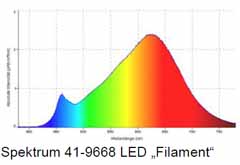
Example of a LED light spectrum
A low power consumption is not the only criterion
Everyone wants to make an active contribution to climate protection and save energy. To achieve this goal, we can use energy saving devices and energy-saving bulbs in the household. But a low power consumption is not the only criterion when we select an appropriate lighting. Scientific studies have confirmed the importance of natural light to our health now detected. Daylight is optimal for our well-being. It has a harmonious color spectrum (red, green, blue) and a low UV component. The conventional light bulb came the natural color spectrum very close. Only the red component was somewhat increased. Even the light from halogen lamps largely corresponds to the natural spectrum. Another advantage of conventional light bulbs and halogen bulbs is a uniform flicker of 100 Hertz and a small proportion of flickering light.
LED lamps to replace incandescent bulbs
The task of the developer of energy-saving lighting is now to produce the most natural light spectrum with a small proportion of flickering light. The development of LED lamps is on the right track. Five years ago, the LED lamps still had too high a proportion of blue. The light spectrum has now improved. The blue component is only slightly increased. Blue light is suspected of hindering the formation of the hormone melatonin and thus compromising the quality of sleep. An important indicator for the color rendering is the color rendering index (Ra or CRI). A Ra of greater than 90 is now achievable with LED lamps. Bulbs have a Ra-value of 100. When you buy the consumer should pay attention to this indicator.
Proportion of flickering light may differ from brands
Differences in quality, there are still at the proportion of flickering light. Very good LED lamps achieve a proportion of less than 3%. Unfortunately some LED lamps are still offered with a proportion of 30 percent and more. The decisive factor is the quality of the voltage source. There are possible frequencies of 50 Hz to a few hundred kilohertz. The proportion of flickering light may vary between 3% and 90%. Pay attention to the details in the light spectrum in the product data sheet, too.
Compact fluorescent lamps (CFLs) are not suitable for indoor use
For the living and working area completely unsuitable are the so-called compact fluorescent lamps, which are commonly referred to as energy-saving lamps. Its light spectrum is totally inharmonious. In the spectrometer can be seen instead of a uniform color distribution only individual peaks in the blue, green and red spectrum. CFLs have a high Proportion of Flickering light, produce short-range electromagnetic fields and enter on certain models a high-pitched buzzing sound from which, however, is to make audible only with a bat detector. In schools and kindergartens should the “energy saving lamps” not be used because of their mercury content. A rational use could be justified in uninhabited areas, for example, in entrance areas, hallways, basements or garages.
The quality of light can be measured
The lighting technology is complicated and susceptible to faults by the electronic components used in CFLs and LED lamps as opposed to the light bulbs. With light-measuring instruments bulbs can be tested prior to purchase. A simple light flicker meter for up to 280 EUR shows the flicker frequency in percentage steps. Devices in a 800-EUR-area also supply the flicker frequency. The color spectrum can be seen with a small spectrometer for 150 EUR. To measure the Ra-value, however, a professional equipment of over 2,000 EUR is required. The Ra value should also be specified by the manufacturer in the product datasheet. Light Meters can be rented on request of building biologists.
